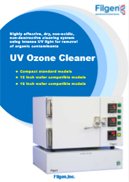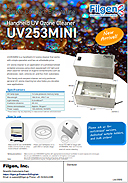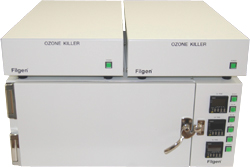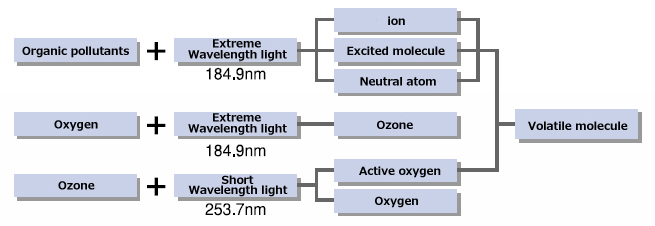Scientific Instruments
|
|
Removal of organic contamination by the dual effect of ozone and ultraviolet
light at two wavelengths
UV Ozone Cleaner |
※The damage-free dry cleaning method can remove the organic contaminations
that stick to the substrates by a photochemical oxidation resolution process. |
 Benefits Benefits

|
【Benefits of UV ozone cleaning method】
|
● |
Easy removal of organic contaminations on the substrate that could not
be removed by ultrasonic cleaning alone. |
| ● |
Removal of the organic solvent used in wet cleaning. |
| ● |
Possibility of removing organic contaminations without damaging the substrate
surface. |
| ● |
Easier accumulation of the L-B film. (cumulative rate is greatly improved.) |
| ● |
Acailable at a tmospheric pressure. Not require vacuum device. |
【Benefits of Filgen's UV ozone cleaner】
|
● |
Compact desktop type that saves space. |
| ● |
Automatic gas switching.
By connecting oxygen pipe and nitrogen pipe and setting the flow rate of
each gas in advance, the device can perform the following steps automatically.
Oxygen introduction → UV cleaning → Nitrogen introduction (Ozone exhaust)
※Oxygen can increase the efficiency of ozone generation and nitrogen can
purge the ozone. |
| ● |
(Straight tube lamp equipped model - UV253V8)
No ozone leak because it has an airtight construction.
The device chamber is an airtight construction that can maintain a pressure
of 0.02 MPa.
When connecting to a gas cylinder, the device can perform the following
steps automatically without the inflow of external air.
Oxygen introduction → UV cleaning → Nitrogen introduction (ozone exhaust).
※Ozone leak can shorten the life of parts of the device itself and can
affect data of chemistry or biological experiments, which can cause serious
problem.
(Other models besides of UV253V8)
No ozone leak when it is connected to an ozone decomposing device.
When connecting to a gas cylinder, the device can perform the following
steps automatically without the inflow if external air.
Oxygen introduction → UV cleaning → Nitrogen introduction (ozone exhaust). |
| ● |
Optional ozone detection system and door lock mechanism are available to
avoid human error that can lead to ozone or UV leak.
(Ozone detection system)
After using an ozone decomposing device or purging with nitrogen, measure
the ozone concentration in the cleaning room. The door will be open after
confirming the ozone concentration fulfilles the safety standard.
(Door lock mechanism)
The dedicated lock mechanism prevents the door from being opened while
the UV lamp is on (during ozone generation).
(Interlocking ozone detection system and door lock mechanism)
By equipping and interlocking the optional ozone detection system and door
lock mechanism, the door cannot be opened unless the ozone concentration
in the cleaning room fulfills the safery standard. |
| ● |
Depending on the application, two different types of UV lamps (straight
tube UV lamps and high density high power grid UV lamps) are available
to be selected.
|
| ● |
For the above two types of low pressure mercury lamps, fused quartz specifications
and synthetic quartz specifications are available. Please select according
to the application.
It is also possible to replace the lamp later, without changing the other
parts of the device.
※The synthetic quartz specification emits 184.9 nm wavelength light much
better (about 1.7 times) than the fused quartz specification, which may
dramatically improve the cleaning efficiency. |
| ● |
Digital timer with count down function. |
| ● |
Optional Ozone killer (ozone docomposing device) equipping can remove and exhaust the ozone and makes the working environment
even safer. |
| ● |
Easy connection because all the nylon tubes and joint connectors are using
one-touch joints. |
| ● |
Flexible length of the connection tube, which is made of nylon and can
be cut freely. |
|
|
|

UV ozone cleaner
Catalogue Download

Handheld UV ozone cleaner
Catalogue Download


 |
 The principal of UV ozone cleaning The principal of UV ozone cleaning

|
UV ozone cleaning is a photosensitive oxidation process using short wavelength
UV light. During this process, organic contaminants such as photoresist,
resin, silicon oil, and flux are decomposed by absorbing UV radiation with
short wavelength.
Oxygen molecules become ozone at the wavelength of 184.9 nm and ozone is
decomposed at a wavelength of 253.7 nm, simultaneously producing reactive
oxygen species.
Most of the 253.7 nm UV light is absorbed by hydrocarbons and ozone.
The products of the decomposed contaminants react with the reactive oxygen
species and form simpler volatile molecules (ex. CO2 H2O etc.), then detach from the substrate surface.
When both 184.9 nm and 253.7nm wavelengths UV light exist, oxygen atoms
continue to be generated and turn into ozone, then the ozone decompose.

Converting the 184.9 nm UV light into energy per mole is 647 KJ/mol.
Converting the 253.7 nm UV light into energy per mole is 472 KJ/mol.
The binding energy of various molecules of organic matter is listed in
the right table. |
|
| Binding |
Binding energy
(KJ/mol) |
Binding |
Binding energy
(KJ/mol) |
| O-O |
138.9 |
C=C |
607 |
| O=O |
490.4 |
C≡C |
828 |
| O-H |
462.8 |
C=O |
724 |
| C-C |
347.7 |
C-Cl |
328.4 |
| C-H |
413.4 |
H-F |
593.2 |
| C-N |
291.6 |
C-F |
441.0 |
| C≡N |
791 |
H-Cl |
431.8 |
| C-O |
351.5 |
N-H |
309.8 |
|
|
|
 Application Application

|
◆Pretreatment of thin film coating
|
ITO film cleaning of the organic EL |
| Substrate cleaning before LB film accumulation |
| Photoresist cleaning |
| Cleaning silicon wafer, lens, mirror, solar panel, cold rolled steel, inertial
induction subcomponent, GaAs wafer |
| Cleaning hybrid circuit and flat panel LCD |
| Improving adhesion of coating to plastic |
| Substrate cleaning process before film formation by dipping method |
◆Electron microscope related applications
|
Removal of contaminants of SEM and/or TEM specimens |
| Improving wettability and affinity of diamond knives and glass knives |
| Improving wettability and hydrophilicity of support film |
◆Ohers
|
Sterilization and washing of the biolabware |
| AFM cantilever |
| PDMS surface modification |
| Cleaning of hermetic seal for ultra-high vacuum |
| Removal of flux |
| Etching of teflon, viton and other organic materials |
| Glass degassing |
| Removal of the wafer tape |
| Ink removal from tested wafer |
| Annealing of Ta2O5 dielectric films |
|
|